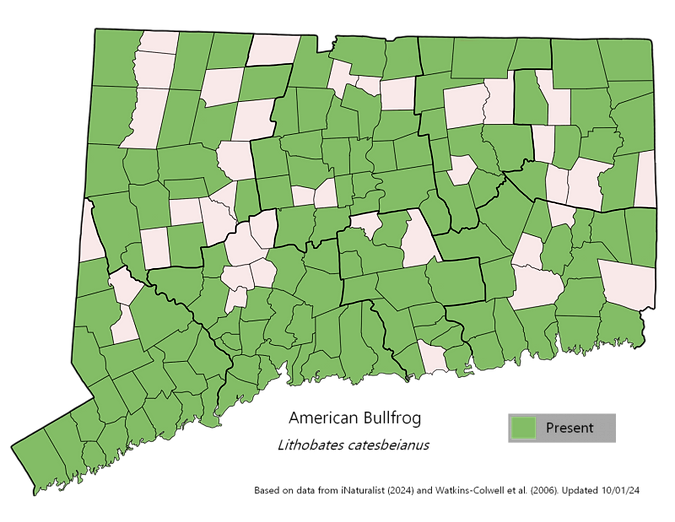American Bullfrog
Lithobates catesbeianus
Conservation Status:
State Status: Secure (NatureServe, 2024)
Global Assessment: Least Concern (IUCN, 2020)
Listen to call:
(Dennis Devita J., 2021)
Description
Bullfrogs are the largest frog in North America, reaching up to eight inches long and weighing over a pound (Watkins-Colwell, 2024). They can range from light green to brown in color and may have darker patterns on their legs and back. Their undersides are white with darker mottling. During the breeding season, males will have yellow throats and females' will remain white.
This species of frog has prominent eardrums, which are located directly behind the eyes. In males, the eardrums are larger than the eyes while in females they are roughly the same size. Bullfrogs have very long hind limbs with large, webbed feet.
Habitat
In Connecticut, bullfrogs can most often be found in larger, permanent water bodies or man-made habitats.
This includes areas such as swamps, ponds, lakes, pools, and ditches. Unlike other species of frogs, bullfrogs do not need to stay away from bodies of water occupied by fish due to their large size. Bullfrogs are native to Connecticut and the Eastern United States, however they have become highly invasive in the Western U.S.
Behavior
Like most frogs, bullfrogs are very skittish, solitary creatures. They are highly aquatic, spending most of their time in or near a body of water. As opportunistic feeders, these frogs will eat anything that can fit in their mouths, including insects, other amphibians, and even snakes. In places where bullfrog populations are particularly high, they have been known to cause declines in other amphibian populations due to their appetites (Quinn, 2020).
Bullfrogs are most active at night, with breeding season occurring
throughout the early summer. They are named after the call that males make, which sounds similar to a bull. Eggs are laid in shallow bodies of water. Unlike most frogs, bullfrogs typically do not lay eggs in vernal pools. This is because their larvae will remain in the tadpole stage for multiple years before going through metamorphosis, and would not be able to survive when the vernal pool dries up. During the winter, this species will stay alive by entering a state of slowed metabolism and staying buried in mud.
Bullfrogs are very widespread across Connecticut, having stable populations with few predators due to their size and aggression. Large birds, snakes, and some mammals may eat these frogs. Humans have also been known to hunt bullfrogs to eat their legs, but this practice is more common in the Southern United States. When threatened they will retreat to deeper water, and are able to swim away quickly.
Range


American Bullfrog
Photographed by Mark Apgar
Often Confused with

Green Frog
Photographed by Alyssa Jones
The American bullfrog is visually similar to the green frog. The easiest way to tell them apart is by looking at the ridge that runs from the back of the frog's eye. In bullfrogs, this ridge wraps around the eardrum (the circular impression located behind the eye). In green frogs this ridge runs from the eye to further down the back. The difference in this ridge can clearly be seen in the images above. Bullfrogs are typically also larger than green frogs, however it would be difficult to identify a frog based on this criteria alone.
References
Dennis Devita J. (2021, June 7). Bullfrog Sounds. YouTube. https://www.youtube.com/watch?v=MwUZRqHeRB0.
iNaturalist. (2024). Observations. California Academy of the Sciences / National Geographic Society. https://www.inaturalist.org/observations?place_id=49&taxon_id=65979.
International Union for Conservation Of Nature and Natural Resources. (2020, December 1). American Bullfrog. https://www.iucnredlist.org/species/58565/193396825.
NatureServe. (2024, November 1). Lithobates catesbeianus. https://explorer.natureserve.org/Taxon/ELEMENT_GLOBAL.2.105926/Lithobates_catesbeianus.
Quinn, D. P. (2020). American Bullfrog. Connecticut Herpetology. https://www.ctherpetology.com/bullfrog.
Watkins-Colwell, G. J. (2024). American Bullfrog - Rana Catesbeiana. Yale Peabody Museum. https://peabody.yale.edu/explore/collections/herpetology/guide-amphibians-reptiles-connecticut.
Watkins-Colwell, G. J. et al. (2006). New Distribution Records for Amphibians and Reptiles in Connecticut, with Notes on the Status of an Introduced Species. Sacred Heart University. https://digitalcommons.sacredheart.edu/cgi/viewcontent.cgi?article=1058&context=bio_fac.
Page updated November 14, 2024
